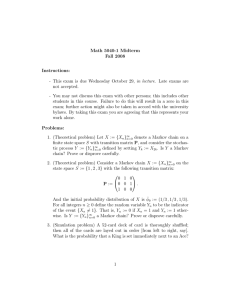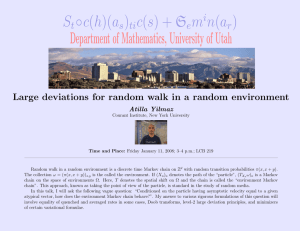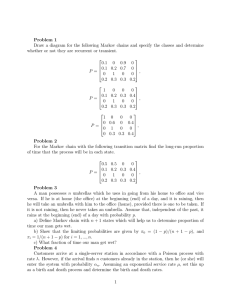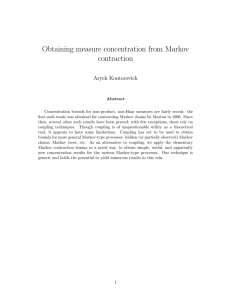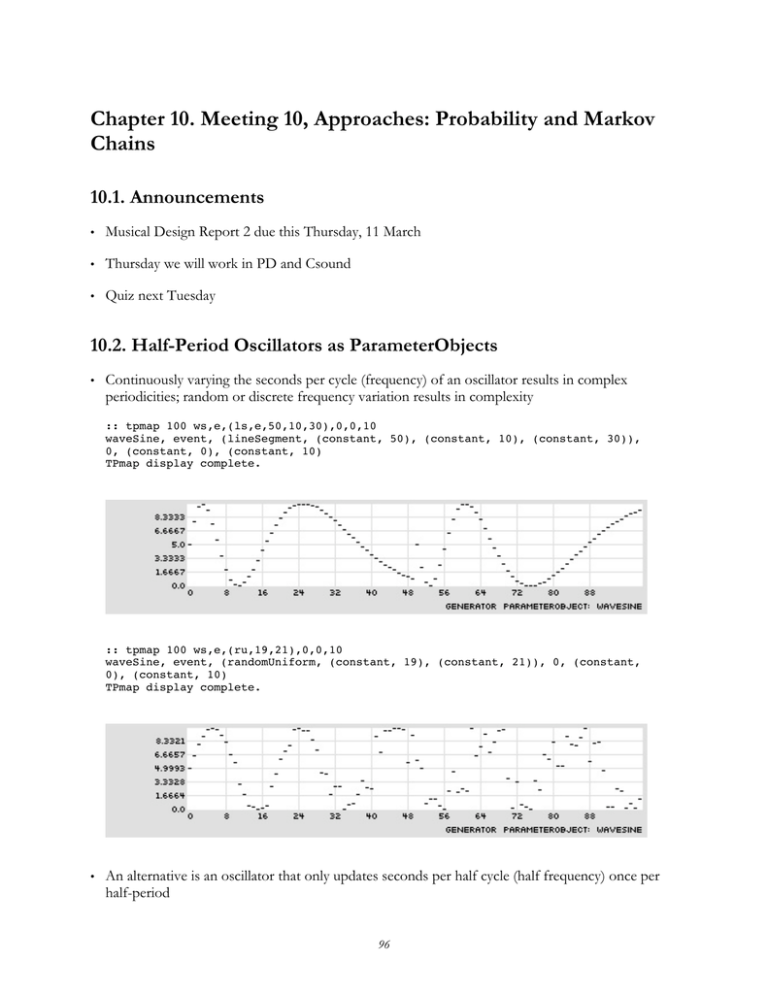
Chapter 10. Meeting 10, Approaches: Probability and Markov
Chains
10.1. Announcements
•
Musical Design Report 2 due this Thursday, 11 March
•
Thursday we will work in PD and Csound
•
Quiz next Tuesday
10.2. Half-Period Oscillators as ParameterObjects
•
Continuously varying the seconds per cycle (frequency) of an oscillator results in complex
periodicities; random or discrete frequency variation results in complexity
:: tpmap 100 ws,e,(ls,e,50,10,30),0,0,10
waveSine, event, (lineSegment, (constant, 50), (constant, 10), (constant, 30)),
0, (constant, 0), (constant, 10)
TPmap display complete.
:: tpmap 100 ws,e,(ru,19,21),0,0,10
waveSine, event, (randomUniform, (constant, 19), (constant, 21)), 0, (constant,
0), (constant, 10)
TPmap display complete.
•
An alternative is an oscillator that only updates seconds per half cycle (half frequency) once per
half-period
96
WaveHalfPeriodSine, WaveHalfPeriodTriangle, WaveHalfPeriodPulse, WaveHalfPeriodCosine
:: tpmap 100 whps,e,(bg,rp,(2,6,10,14,18)),0,0,10
waveHalfPeriodSine, event, (basketGen, randomPermutate, (2,6,10,14,18)), 0,
(constant, 0), (constant, 10)
TPmap display complete.
:: tpmap 100 whpt,e,(bg,rp,(2,6,10,14,18)),0,0,10
waveHalfPeriodTriangle, event, (basketGen, randomPermutate, (2,6,10,14,18)), 0,
(constant, 0), (constant, 10)
TPmap display complete.
:: tpmap 100 whpp,e,(bg,rp,(2,6,10,14,18)),0,0,10
waveHalfPeriodPulse, event, (basketGen, randomPermutate, (2,6,10,14,18)), 0,
(constant, 0), (constant, 10)
TPmap display complete.
10.3. Markov Analysis and Generation: Basics
•
Examine an ordered sequence states
•
Given an event at n-1, what is the probability of any state (of all possible states) at n?
97
•
Look at all possible n-1 states, and find how often they move to each state at n
•
Use these probabilities to re-generate new sequences (where more frequent states result in
proportionally weighted randomness)
10.4. Markov Analysis and Generation: Orders
•
Zeroth order: examine 0 past states; given all possible states, generate n based on the distribution
of all states.
•
First order: examine 1 past state; generate n based on the probability of n-1 moving to each state.
•
Second order: examine 2 past states; generate n based on the probability of n-2 and n-1 moving to
each state.
•
Second order: examine 3 past states; generate n based on the probability of n-3, n-2 and n-1
moving to each state.
•
The greater the order, the more the past is taken into account in determining the next state
•
The greater the order, the more the output is similar to the source
10.5. Reading: Ames: The Markov Process as a Compositional Model:
A Survey and Tutorial
•
Ames, C. 1989. “The Markov Process as a Compositional Model: A Survey and Tutorial.”
Leonardo 22(2): 175-187.
•
What does Ames refer to by stationary probabilities
•
What does Ames claim as the greatest strength of Markov chains?
•
What technique does Ames suggests as a way to create large-scale behavior out of Markov chains?
10.6. Markov Chains: History
•
1906: Andrey Andreyevich Markov, Russian mathematician
Used Markov chains to show tendencies in written Russian in a text by Pushkin
•
1949: Claude E. Shannon and Warren Weaver: A Mathematical Theory of Communication; associated
with information theory
•
Demonstrate using stochastic processes to generate English sentences
•
Suggest application to any sequence of symbols, including music
98
10.7. Markov Chains: History: Early Musical Applications
•
The “Banal Tune-Maker” of Richard C. Pinkerton (1956)
© Scientific American, Inc. All rights reserved. This content is excluded from our
Creative Commons license. For more information, see http://ocw.mit.edu/fairuse.
99
© Scientific American, Inc. All rights reserved. This content is excluded from our
Creative Commons license. For more information, see http://ocw.mit.edu/fairuse.
•
John F. Sowa with a Geniac “Electronic Brain Kit” (1957)
100
© Oliver Garfield Co., Inc. All rights reserved. This content is excluded from our
Creative Commons license. For more information, see http://ocw.mit.edu/fairuse.
101
© Oliver Garfield Co., Inc. All rights reserved. This content is excluded from our Creative
Commons license. For more information, see http://ocw.mit.edu/fairuse.
102
Courtesy of John F. Sowa. Used with permission.
103
•
1961: Harry Olson and Herbert Belar build a sophisticated electronic machine that produced and
synthesized melodices based on Markovian pitch and rhythm analysis of eleven Stephen Collins
Foster songs (1961)
Source: Olson, H. F., and H. Belar. "Aid to Music Composition Employing a Random Probability System."
J. Acoust. Soc. Am. 33, no. 9 (1961): 1163-1170.
© Acoustical Society of America. All rights reserved. This content is excluded from our Creative Commons license.
For more information, see http://ocw.mit.edu/fairuse.
104
Source: Olson, H. F., and H. Belar. "Aid to Music Composition Employing a Random Probability System."
J. Acoust. Soc. Am. 33, no. 9 (1961): 1163-1170.
© Acoustical Society of America. All rights reserved. This content is excluded from our Creative Commons license.
For more information, see http://ocw.mit.edu/fairuse.
105
Source: Olson, H. F., and H. Belar. "Aid to Music Composition Employing a Random Probability System."
J. Acoust. Soc. Am. 33, no. 9 (1961): 1163-1170.
© Acoustical Society of America. All rights reserved. This content is excluded from our Creative Commons license.
For more information, see http://ocw.mit.edu/fairuse.
•
David Zicarelli’s Jam Factory and Joel Chadabe and Zicarelli’s M (1987)
106
Courtesy of Cycling '74. Used with permission.
107
10.8. Markov Chains: Example: Shakespear
•
Hamlet Act 3, Scene 1, Soliloquy
YouTube (http://www.youtube.com/watch?v=-JD6gOrARk4)
•
Shakespear: Hamlet: “To be or not to be”
To be, or not to be- that is the question: Whether ’tis nobler in the mind to suffer The slings and arrows of outrageous fortune
Or to take arms against a sea of troubles,
And by opposing end them. To die- to sleep- No more; and by a sleep to say we end
The heartache, and the thousand natural shocks That flesh is heir to. ’Tis a consummation Devoutly to be wish’d. To die- to sleep. To sleep- perchance to dream: ay, there’s the rub! For in that sleep of death what dreams may come
When we have shuffled off this mortal coil, Must give us pause. There’s the respect
That makes calamity of so long life.
For who would bear the whips and scorns of time,
Th’ oppressor’s wrong, the proud man’s contumely, The pangs of despis’d love, the law’s delay,
The insolence of office, and the spurns
That patient merit of th’ unworthy takes,
When he himself might his quietus make
With a bare bodkin? Who would these fardels bear, To grunt and sweat under a weary life,
But that the dread of something after death- The undiscover’d country, from whose bourn
No traveller returns- puzzles the will, And makes us rather bear those ills we have Than fly to others that we know not of?
Thus conscience does make cowards of us all,
And thus the native hue of resolution Is sicklied o'er with the pale cast of thought,
And enterprises of great pith and moment
With this regard their currents turn awry
And lose the name of action.- Soft you now! The fair Ophelia!- Nymph, in thy orisons Be all my sins rememb'red. •
0-order Markov re-generation
wish’d. contumely, Be contumely, the Devoutly thus pangs by thy of fardels makes name
consummation pale Who we to respect coil, the to be and To Nymph, Th’ That No ’Tis There’s
And the cowards of that When the weary or To a against wrong, And name With th’ we thought,
the sins That To my wrong, off perchance those Be scorns To his a that With others The quietus
currents fly wrong, weary that To traveller time, When have scorns wrong, pale traveller against of
make scorns quietus of delay, sleep. awry With to currents in and With cast coil, But have may
arms Th’ take arrows and The those their to regard the end we coil, fortune take
•
1-order Markov re-generation
108
die to others that is the name of so long life. For in the will, And enterprises of great pith and
scorns of thought, And enterprises of thought, And lose the proud man’s contumely, The
undiscover’d country, from whose bourn No more; and the whips and moment With this regard
their currents turn awry And lose the proud man’s contumely, The slings and sweat under a sleep
perchance to dream: ay, there’s the whips and scorns of office, and arrows of great pith and
scorns of something after death what dreams may come When he himself might his quietus make
With this regard their currents turn awry And makes us pause. There’s the law’s delay, The
heartache, and arrows of
•
2-order Markov re-generation
To be, or not to be wish’d. To die to sleep No more; and by a sleep to say we end The heartache,
and the thousand natural shocks That flesh is heir to. ’Tis a consummation Devoutly to be wish’d.
To die to sleep No more; and by a sleep to say we end The heartache, and the thousand natural
shocks That flesh is heir to. ’Tis a consummation Devoutly to be wish’d. To die to sleep No
more; and by a sleep to say we end The heartache, and the thousand natural shocks That flesh is
heir to. ’Tis a consummation Devoutly to be that is the question: Whether ’tis nobler in the mind
to suffer The slings and
•
3-order Markov re-generation
the name of action. Soft you now! The fair Ophelia! Nymph, in thy orisons Be all my sins
rememb'red. To be, or not to be wish’d. To die to sleep No more; and by a sleep to say we end
The heartache, and the thousand natural shocks That flesh is heir to. ’Tis a consummation
Devoutly to be that is the question: Whether ’tis nobler in the mind to suffer The slings and
arrows of outrageous fortune Or to take arms against a sea of troubles, And by opposing end
them. To die to sleep No more; and by a sleep to say we end The heartache, and the spurns That
patient merit of th’ unworthy takes, When he himself
•
4-order Markov re-generation
those ills we have Than fly to others that we know not of? Thus conscience does make cowards
of us all, And thus the native hue of resolution Is sicklied o'er with the pale cast of thought, And
enterprises of great pith and moment With this regard their currents turn awry And lose the name
of action. Soft you now! The fair Ophelia! Nymph, in thy orisons Be all my sins rememb'red. To
be, or not to be wish’d. To die to sleep No more; and by a sleep to say we end The heartache, and
the thousand natural shocks That flesh is heir to. ’Tis a consummation Devoutly to be that is the
question: Whether ’tis nobler in the
•
5-order Markov re-generation
we have shuffled off this mortal coil, Must give us pause. There’s the respect That makes calamity
of so long life. For who would bear the whips and scorns of time, Th’ oppressor’s wrong, the
proud man’s contumely, The pangs of despis’d love, the law’s delay, The insolence of office, and
the spurns That patient merit of th’ unworthy takes, When he himself might his quietus make
With a bare bodkin? Who would these fardels bear, To grunt and sweat under a weary life, But
that the dread of something after death The undiscover’d country, from whose bourn No
109
traveller returns puzzles the will, And makes us rather bear those ills we have Than fly to others
that we know
10.9. Markov Chains: Example: Mozart Symphony 40
•
Audio: Mozart: Symphony 40
•
Pitch and rhythm based Markov regeneration at various orders
•
Markov-generated examples [markovMozart.py]
10.10. Markov Analysis and Generation with athenaCL Python
Libraries: Text
•
Use the athenaCL Markov module
•
Create a markov.Transition instances to do analysis
•
Example: string data [markovShakespear.py]
import random
from athenaCL.libATH import markov
src = """To be, or not to be- that is the question: Whether 'tis nobler in the mind to suffer The slings and arrows of outrageous fortune
Or to take arms against a sea of troubles,
And by opposing end them. To die- to sleep- No more; and by a sleep to say we end
The heartache, and the thousand natural shocks
That flesh is heir to. 'Tis a consummation Devoutly to be wish'd. To die- to sleep.
To sleep- perchance to dream: ay, there’s the rub!
For in that sleep of death what dreams may come
When we have shuffled off this mortal coil,
Must give us pause. There’s the respect
That makes calamity of so long life.
For who would bear the whips and scorns of time,
Th' oppressor’s wrong, the proud man’s contumely,
The pangs of despis'd love, the law’s delay,
The insolence of office, and the spurns
That patient merit of th' unworthy takes,
When he himself might his quietus make
With a bare bodkin? Who would these fardels bear,
To grunt and sweat under a weary life,
But that the dread of something after death- The undiscover'd country, from whose bourn
No traveller returns- puzzles the will,
And makes us rather bear those ills we have
Than fly to others that we know not of?
110
Thus conscience does make cowards of us all,
And thus the native hue of resolution
Is sicklied o'er with the pale cast of thought,
And enterprises of great pith and moment
With this regard their currents turn awry
And lose the name of action.- Soft you now!
The fair Ophelia!- Nymph, in thy orisons Be all my sins rememb'red.""" orderMax = 2 # large numbers here will take time!
mkObj = markov.Transition()
mkObj.loadString(src, orderMax) # source and max order1
for order in range(0, orderMax+1):
print('requested order: ' + order)
msg = []
for x in range(120):
val = random.random()
msg.append(mkObj.next(val, msg, order))
print(' '.join(msg) + '\n') 10.11. Markov Analysis and Generation with athenaCL Python
Libraries: MIDI
•
Example: pitch and rhythm data [markovMozart.py]
import os, random, sys
from athenaCL.libATH import midiTools
from athenaCL.libATH import osTools
from athenaCL.libATH import pitchTools
from athenaCL.libATH import rhythm
from athenaCL.libATH import markov
from athenaCL.libATH.libOrc import generalMidi
from athenaCL.libATH.libPmtr import parameter
from athenaCL.libATH.libPmtr import basePmtr
OUTDIR = '/Volumes/xdisc/_scratch'
BEATDUR = rhythm.bpmToBeatTime(128) # provide bpm value
def getInstName(nameMatch):
for name, pgm in generalMidi.gmProgramNames.items():
if name.lower().startswith(nameMatch.lower()):
return pgm # an integer
return None
def convertPitch(src, octShift):
post = []
for pitch in src:
midiPs = pitchTools.psToMidi(pitchTools.psNameToPs(pitch))
midiPs = midiPs + (12*octShift)
post.append(midiPs)
return post # a list of integers
def convertRhythm(src, scale):
post = []
for rhythm in src:
post.append(rhythm*scale)
return post # a list of integers
def mozartMarkov(events, order, octaveShift, rhythmScale):
pitchSequence = [
111
'E$5','D5','D5','E$5','D5','D5','E$5','D5','D5',
'B$5','B$5','A5','G5','G5','F5','E$5','E$5','D5','C5','C5',
'D5','C5','C5', 'D5','C5','C5', 'D5','C5','C5',
'A5','A5','G5','G$5','G$5','E$5','D5','D5','C5','B$4','B$4',
'B$5','A5','A5','C6','G$5','A5','G5','D5',
'B$5','A5','A5','C6','G$5','A5','G5','B$5','A5','G5','F5','E$5',
'D5','D$5','D5',
'D4','D4','D4', 'D4','D4','D4', 'D4','D4','D4', 'D4','D4','D4', 'D4','D4','D4'] rhtyhmSequence = [
.5, .5, 1, .5, .5, 1, .5, .5, 1, 1,
.5, .5, 1, .5, .5, 1, .5, .5, 1, 2,
.5, .5, 1, .5, .5, 1, .5, .5, 1,
2, .5, .5, 1, .5, .5, 1, .5, .5, 1, 2,
.5, .5, 1, 1, 1, 1, 1, 2,
.5, .5, 1, 1, 1, 1, 1, 1, .5, .5, .5, .5,
4, 4, 3,
.5, .5, 3, .5, .5, 3,
.5, .5, 1, .5, .5, 1, .5, .5, 1]
mkPitch = markov.Transition()
mkRhythm = markov.Transition() mkPitch.loadList(convertPitch(pitchSequence, octaveShift), order)
mkRhythm.loadList(convertRhythm(rhtyhmSequence, rhythmScale), order)
pitchHistory = []
rhythmHistory = []
ampGen = parameter.factory(['ws','e',4,0,100,120]) # sine osc b/n 90 and 120 f = random.choice(range(50,70))
phase = random.random()
panGen = parameter.factory(['ws','e',f,phase,20,107])
score = []
tStart = 0.0
for i in range(events):
pitch = mkPitch.next(random.random(), pitchHistory, order)
pitchHistory.append(pitch)
rhythm = mkRhythm.next(random.random(), rhythmHistory, order)
rhythmHistory.append(rhythm)
dur = BEATDUR * rhythm
amp = int(round(ampGen(0)))
pan = int(round(panGen(0)))
event = [tStart, dur, amp, pitch, pan]
score.append(event)
tStart += dur
return score
def main(order):
trackList = []
score = mozartMarkov(100, order, -1, 1) trackList.append(['part-a', getInstName('piano'), None, score])
path = os.path.join(OUTDIR, 'test.midi')
mObj = midiTools.MidiScore(trackList)
mObj.write(path) # writes in cwd
osTools.openMedia(path)
if __name__ == '__main__': if len(sys.argv) != 2:
print(“args: order”)
else:
main(int(sys.argv[1]))
112
10.12. Reading: Ariza: Beyond the Transition Matrix: A LanguageIndependent, String-Based Input Notation for Incomplete, MultipleOrder, Static Markov Transition Values
•
Ariza, C. 2006. “Beyond the Transition Matrix: A Language-Independent, String-Based Input
Notation for Incomplete, Multiple-Order, Static Markov Transition Values.” Internet:
http://www.flexatone.net/docs/btmimosmtv.pdf.
•
What are some potential advantages of the transition string over the transition matrix?
•
Why might modulating Markov order be desirable?
10.13. Utility Markov Analysis and Generation within athenaCL
•
AUma command can be used to get an analysis string for an space-separated sequence
:: auma
maximum analysis order: 1
enter space-separated string: 0 1 1 1 1 0 1 2 3 4 0 0 2 1 3 2 4 0 0
AthenaUtility Markov Analysis
a{0}b{1}c{2}d{3}e{4}:{a=6|b=6|c=3|d=2|e=2}a:{a=3|b=2|c=1}b:{a=1|b=3|c=1|d=1}c:{b=1|d
=1|e=1}d:{c=1|e=1}e:{a=2}
•
AUmg command can be used to use a transition string to generate values
:: aumg
number of generations: 20
desired order: 1
enter Markov transition string:
a{0}b{1}c{2}d{3}e{4}:{a=6|b=6|c=3|d=2|e=2}a:{a=3|b=2|c=1}b:{a=1|b=3|c=1|d=1}c:{b=1|d
=1|e=1}d:{c=1|e=1}e:{a=2}
AthenaUtility Markov Generator
4,0,1,1,1,1,1,3,2,1,1,1,1,1,2,4,0,0,1,0
10.14. Markov-Based Proportional Rhythm Generation
•
The MarkovPulse Generator permits specifying proportional rhythms (pulse truples) as Markov
states
:: tpv markovpulse
Rhythm Generator ParameterObject
{name,documentation}
MarkovPulse
markovPulse, transitionString, parameterObject
Description: Produces Pulse sequences by means of a Markov
transition string specification and a dynamic transition
order generator. The Markov transition string must define
symbols that specify valid Pulses. Markov transition order
is specified by a ParameterObject that produces values
between 0 and the maximum order available in the Markov
transition string. If generated-orders are greater than
those available, the largest available transition order will
be used. Floating-point order values are treated as
probabilistic weightings: for example, a transition of 1.5
113
offers equal probability of first or second order selection.
Arguments: (1) name, (2) transitionString, (3)
parameterObject {order value}
•
Command sequence:
•
emo mp
•
tin a 64
•
simple zero-order selection
tie r mp,a{4,1}b{4,3}c{4,5}d{4,7}:{a=4|b=3|c=2|d=1}
•
first order generation that encourages movement toward the shortest duration
tie r mp,a{8,1}b{4,3}c{4,7}d{4,13}a:{a=9|d=1}b:{a=5|c=1}c:{b=1}d:{c=1},(c,1)
•
eln; elh
10.15. Markov-Based Value Generation
•
The MarkovValue Generator permits specifying any value as Markov states, and dynamically
moving between different Markov orders
:: tpv mv
Generator ParameterObject
{name,documentation}
MarkovValue
markovValue, transitionString, parameterObject
Description: Produces values by means of a Markov transition
string specification and a dynamic transition order
generator. Markov transition order is specified by a
ParameterObject that produces values between 0 and the
maximum order available in the Markov transition string. If
generated-orders are greater than those available, the
largest available transition order will be used. Floating- point order values are treated as probabilistic weightings:
for example, a transition of 1.5 offers equal probability of
first or second order selection. Arguments: (1) name, (2) transitionString, (3) parameterObject {order value}
:: tpmap 100
mv,a{2}b{4}c{7}d{9}e{11}:{a=1|b=3|c=1|d=3|e=1}a:{a=9|e=1}b:{a=3|c=1}c:{b=3|d=1}d:{c=
3|e=1}e:{d=1},(c,1)
markovValue, a{2}b{4}c{7}d{9}e{11}:{a=1|b=3|c=1|d=3|e=1}a:{a=9|e=1}b:{a=3|c=1}c:
{b=3|d=1}d:{c=3|e=1}e:{d=1}, (constant, 1)
TPmap display complete.
114
•
The modulating the order of the Markov chain can create dynamic long-range behavior
:: tpmap 100
mv,a{2}b{4}c{7}d{9}e{11}:{a=1|b=3|c=1|d=3|e=1}a:{a=9|e=1}b:{a=3|c=1}c:{b=3|d=1}d:{c=
3|e=1}e:{d=1},(wp,e,50,0,1,0)
markovValue, a{2}b{4}c{7}d{9}e{11}:{a=1|b=3|c=1|d=3|e=1}a:{a=9|e=1}b:{a=3|c=1}c:
{b=3|d=1}d:{c=3|e=1}e:{d=1},
TPmap display complete.
•
Command sequence:
•
emo m
•
tin a 26
•
rhythm generated with absolute values via ConvertSecond and a dynamic WaveHalfPeriodSine generator
tie r cs,(whps,e,(bg,rp,(5,10,15,20)),0,.200,.050)
•
first-order selection
tie f
mv,a{2}b{4}c{7}d{9}e{11}:{a=1|b=3|c=1|d=3|e=1}a:{a=9|e=1}b:{a=3|c=1}c:{b=3|d
=1}d:{c=3|e=1}e:{d=1},(c,1)
•
dynamic first and zero order selection
tie f
mv,a{2}b{4}c{7}d{9}e{11}:{a=1|b=3|c=1|d=3|e=1}a:{a=9|e=1}b:{a=3|c=1}c:{b=3|d
=1}d:{c=3|e=1}e:{d=1},(wp,e,100,0,1,0)
•
zero-order Markov amplitude values
115
tie a mv,a{.4}b{.6}c{.8}d{1}:{a=6|b=4|c=3|d=1}
•
amplitude values scaled by a dynamic WaveHalfPeriodPulse
tie a om,(mv,a{.4}b{.6}c{.8}d{1}:{a=6|b=4|c=3|d=1}),(whpp,e,(bg,rp,(5,15,10)))
•
octave values are provided by a first-order Markov chain
tie o mv,a{0}b{-1}c{-2}d{-3}a:{a=9|d=1}b:{a=3|b=1}c:{b=3|c=1}d:{c=1},(c,1)
•
tie t 0,60
•
eln; elh
10.16. Markov-Based Combined Analysis and Generation
•
The MarkovGeneratorAnalysis Generator permits using the output of a ParameterObject as the
source for Markov analysis
:: tpv mga
Generator ParameterObject
{name,documentation}
MarkovGeneratorAnalysis markovGeneratorAnalysis, parameterObject, valueCount,
maxAnalysisOrder, parameterObject
Description: Produces values by means of a Markov
analysis of values provided by a source Generator ParameterObject; the analysis of these values is used
with a dynamic transition order Generator to produce new
values. The number of values drawn from the source
Generator is specified with the valueCount argument. The
maximum order of analysis is specified with the
maxAnalysisOrder argument. Markov transition order is
specified by a ParameterObject that produces values
between 0 and the maximum order available in the Markov
transition string. If generated-orders are greater than
those available, the largest available transition order
will be used. Floating-point order values are treated as
probabilistic weightings: for example, a transition of
1.5 offers equal probability of first or second order
selection. Arguments: (1) name, (2) parameterObject
{source Generator}, (3) valueCount, (4)
maxAnalysisOrder, (5) parameterObject {output order value}
•
First order analysis and regeneration of a sine oscillation
:: tpmap 100 mga,(ws,e,30),30,2,(c,1)
markovGeneratorAnalysis, (waveSine, event, (constant, 30), 0, (constant, 0),
(constant, 1)), 30, 2, (constant, 1)
TPmap display complete.
116
•
Analysis and regeneration of a sine oscillation with dynamic orders from 0.5 to 1.5
Floating-point orders are treated as probabilistic weightings toward nearest integers
:: tpmap 100 mga,(ws,e,30),30,2,(ws,e,50,0,0.5,1.5)
markovGeneratorAnalysis, (waveSine, event, (constant, 30), 0, (constant, 0),
(constant, 1)), 30, 2, (waveSine, event, (constant, 50), 0, (constant, 0.5),
(constant, 1.5))
TPmap display complete.
10.17. Resuming PD Tutorial
•
PD Tutorial
117
MIT OpenCourseWare
http://ocw.mit.edu
21M.380 Music and Technology: Algorithmic and Generative Music
Spring 2010
For information about citing these materials or our Terms of Use, visit: http://ocw.mit.edu/terms.


